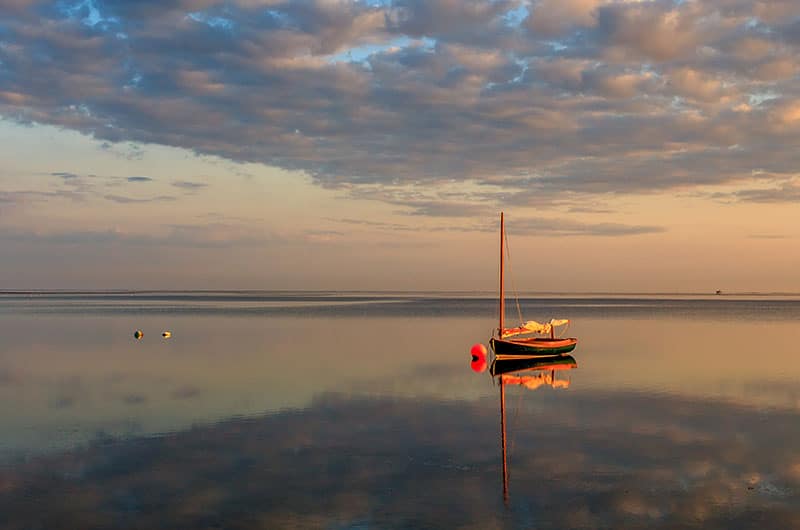~ by Robert P. Barsanti ~
I think we forget how little land Nantucket actually has. If you nibble the sandy, pointy ends off, the island stretches barely fifteen miles across and four miles. Further, the island’s streets, sidewalks, and stores aren’t designed for the 60,000 people that move into their homes in July. On a Wednesday morning, in the middle of July, half of them were lined up on Old South Road, creeping their way into town. I crept right along after them, holding a bag of disappointment from the Bake Shop. The Honey Dipped donuts had run out the door thirty minutes before I arrived.
In the past, I could skip in and out of my favorite sugar emporiums if I watched the clock. If I got to the Downyflake before eight, I could get a seat and a dozen warm sugar donuts. If I got to the Juice Bar between six and seven in the evening, the line barely reached the door. If I got to Henry’s Jr. before 11:30, my lunch landed in my hand after I opened the door.
Not anymore. I have been forced to choose between sugary, fatty, starchy goodness and standing in line. The ice cream scooper from Middlebury shrugged at me. “What can I say? We are overloaded.”
We were overloaded at the beach. I have a favorite beach on the South Shore, a short distance from beer and seafood, that has also become overloaded. On that same Wednesday afternoon, the road was lined up, in parade formation, with Suburbans, Escalades, Land Rovers, Landcruisers, and one Mini convertible perched precariously on its frame. Down on the beach, families the size of hockey teams huddled in beach chairs. Out on the water, three surfers on long boards staggered and fell through a half dozen boogie boards on knee high waves. Everyone left the water with their teeth intact, but the guardian angels were on high alert. East and west, we lay on towels, sat on chairs, and watched the Angels do their dangerous work in the water. We pushed right up to the edge of the little land Nantucket has, and looked over the edge at a Hedge Fund novice steer a long board through middle schoolers.
But for as little land as Nantucket has, it is surrounded by miles and miles of empty ocean. One way to see Coatue is a narrow strip of land, but another way is to see the wide spaces of the harbor and the even wider Sound. On another busy day of Nantucket traffic and Nantucket business, I sat out in a small group beyond First Point, watching the scup swim on the fishfinder. Sitting out on the water puts you miles from brake lights and bicycles.
We had parked at Monomoy, waded out to a twenty-year-old Boston Whaler then slowly navigated the mooring field. The boat, like many island boats, had passed from one fisherman to another, and would probably pass to another generation soon enough. The eel grass and sand eddied into the corners, the console had faded to a gentle but warped tan, and the seats had holes that made noises perfect for middle school boys.
Which was perfect for the middle schoolers who had come with us. They squirmed and jumped on the flatulent seats, then they fussed and fiddled with their fishing rods. On this night, they took another step into adulthood; they all baited their own hooks with squid. Just past First Point, we slowed and drifted until the school appeared on the fish finder. The anchor went over, followed by the squid. Then we waited.
The tide was slipping out. It swung us at anchor and tugged us back to town. In the mooring field, several sterns had wine drinkers sitting back and regarding town from a pleasant distance. Beyond the windmills and church towers, a deep blue fog bank built along the south shore. The sun warmed us still and the wind blew swirls of mist overhead, but we remained safe, silent, and alone.
Soon, the young men and their sister began reeling in skup after skup. They plucked the hooks out, deposited the fish into a green pickle bucket, then rebaited and recast. My host opened a box of low fat wheat thins and a package of cheese, which he cut with a rusty (or bloody?) knife from the bottom drawer of the console. We drank cheap beer, ate rust flecked cheese and crackers, and watched the pickle bucket fill with doomed fish.
Later, after the fog drove us back to shore, we would clean, bread, and fry the fish. Later, we would sit on a patio and eat the fruit of our children’s hands, wrapped in tortillas and surrounded by salsa, cheese, and lettuce. Later, in the wet evening, we would finish the beers and the fish, then watch the children chase the dog into exhaustion and listen to the Red Sox sink beneath the waves of the American League East.
But for right now, we enjoyed the best that Nantucket has. We sat at anchor in the pleasant chill of a July evening, alone on the water. The sun reddened as it slipped into the low clouds. Waves lapped and slapped the sides of the boat, along with the triumphs of the young fishermen. Right here, right now, we made the memories we needed to keep.
The overload remained on the South Shore and at the Rotary; we can’t put 60,000 people on an island fifteen miles long and not expect a lot of brake lights and bad thoughts. But, the beauty of Nantucket shines when you step away from the cars and the roads and you wander. The island is only as small as the crowds you follow. But if you leave the crowds to their ice cream cones and donuts, the island waits for you alone.

